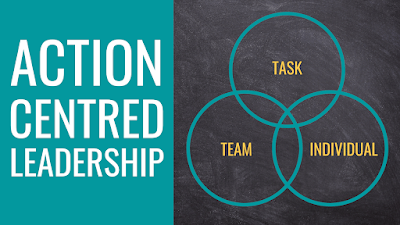Back in 1973,
British leadership expert John Adair published his action centered leadership
model. It’s also known as the “three-circle” model. He developed this model
during the 60s to show a more relevant and modern leadership approach.
Model of
Action-Centered Leadership is developed by focusing on what leaders do and is
based on the following principles:
- The task can only be performed by
the team rather than any one person/leader
- The team will excel only when all
members are fully developed
- The members must be motivated and
need to challenge the task
- Leadership can be taught; if one
person can do something, then others can also learn to do it
Adair’s action
model can be represented by Adair’s three circles, which illustrates his three
core management responsibilities. Each of these three elements plays an
important role in the leadership, and only when all three are balanced
properly, the leader is going to be successful and effective:
1. Achieving
the task: Task is the
foundation that creates the need for leadership. Without the task, there is no
need for any leadership. Every leadership role is developed because there is a
goal in mind, and someone needs to be in charge of directing the team toward
that goal.
2. Managing
the team or group: To
achieve tasks, the team is essential. The team is made up of individuals having
different skills and experiences, and they collectively contribute to the
business goal. A leader’s key responsibility is to motivate the team members to
put in their best for the best possible performance towards completing the
task.
3.
Managing/Empowering individuals: The
leader is responsible for each individual employee, his progress, and
development. Forgetting about individuals as humans and treating them only as a
resource that must do what is best for the organization is a big leadership
mistake. Extracting the best effort from each person on the team requires
treating them with trust and respect as individuals that they are. Each
individual needs recognition by means of salary, fun, and challenging work and
responsibility.
Adair focused
on 8 key functions for action centered leadership to happen.
- Defining the task: here we are creating clarity and
setting the direction. We should use SMARTER goals to help achieve these
results.
- Planning: it’s about having a strategy to
achieve the task. We need to look at all options and take suggestions from
the team when planning what to do and how to do it.
- Briefing the team: we need to communicate with the
team regularly. Here we are providing feedback and accepting
input.
- Controlling what happens: we will have control measures in
place to maintain standards. These measures will ensure we are monitoring
the situation and taking action when needed.
- Evaluating results: it’s important that we’re
reviewing individual and team performance and tracking milestones. We also
need to identify areas of improvement.
- Motivating individuals: we are responsible for providing
recognition and praise, using motivators effectively. Therefore, we
are keeping the team driven to achieve the results.
- Organizing people: All leaders need to have the
capability of arranging the team into a highly functional unit. We do this
by using time management, delegation, and development to keep people
on track.
- Setting an example: here we need to lead by example.
We cannot expect the team to follow our lead if we are
inconsistent.
As you can see,
all 3 elements of Task, Team and Individual feature throughout these key
functions.
Some criticize
the hierarchical approach that Adair’s theory takes, claiming it does not allow
for modern organizational structures that tend to be more linear. Current
thinking suggests that leadership should focus on empowerment, enabling and
encouraging innovation, whereas Adair takes a more traditional approach which
could be seen as authoritarian.
However, others
claim that the simplicity of Adair’s model makes it ‘timeless’ and the simple,
practical framework provides clarity to the role of a leader. The simplicity of
Adair’s ideas results in this model being relevant to leaders, irrespective of
the sector they work in and the task being completed.
Successful
implementation of Adair’s model will enable leaders to
- Build morale
- Achieve
strong results
- Improve work
quality
- Develop
strong teams
- Improve
productivity
Overall, I
highly recommend learning this simple model and using action centered
leadership. This approach will help us focus on those 3 key elements better. It
also allows us to practice those 8 functions that Adair highlighted to allow
this model to work even better. Give it a try and see the benefits.



No comments:
Post a Comment